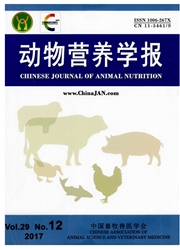

 中文摘要:
中文摘要:
本试验旨在研究藏绵羊和山羊在相同营养及湿热应激条件下血清激素、抗氧化和免疫指标的变化规律,考察湿热应激对藏绵羊和山羊生长性能、抗氧化能力以及免疫功能影响的差异。选取年龄和体重[(45.83±3.54)kg]相近的藏绵羊与山羊(波尔山羊×本地黄羊)各6只,试验共进行135 d,其中预试期15 d,正试期120 d。每日测定温湿度指数(THI),每月测定藏绵羊和山羊的血清相关指标。结果表明:1)5—7月份,羊舍THI随月份的增加显著升高(P〈0.05),6—8月份羊舍THI均大于72,因此将6—8月份定为湿热应激期。2)7、8月份藏绵羊和山羊直肠温度和呼吸频率均显著高于5月份(P〈0.05),且湿热应激期内藏绵羊直肠温度和呼吸频率均显著高于山羊(P〈0.05)。3)正试期内,湿热应激使得藏绵羊和山羊的干物质采食量最大降幅分别为10.70%和10.44%,平均日增重(ADG)最大降幅分别为50.00%和47.82%。4)羊舍THI由71.17(5月份)升高到76.82(7月份),藏绵羊和山羊血清皮质醇和胰岛素浓度显著升高(P〈0.05),血清葡萄糖和三碘甲状腺原氨酸浓度显著降低(P〈0.05)。湿热应激下,藏绵羊血清中生长激素和甲状腺素浓度的最大降幅均大于山羊。5)除藏绵羊7月份和山羊8月份血清总抗氧化能力,藏绵羊和山羊7、8月份的血清超氧化物歧化酶、谷胱甘肽过氧化物酶活性和总抗氧化能力均显著低于5月份(P〈0.05)外,血清丙二醛浓度均显著高于5月份(P〈0.05)。湿热应激下,山羊血清超氧化物歧化酶活性、总抗氧化能力和丙二醛浓度变化幅度均大于藏绵羊。6)与5月份相比,藏绵羊和山羊8月份的血清免疫球蛋白A、免疫球蛋白M、免疫球蛋白G和白细胞介素-2浓度显著降低(P〈0.05),而血清肿瘤坏死因子-α浓度则显著升高(P〈0.05)。湿热应激下,藏绵羊血清免疫球蛋白、白细胞介素-2和?
 英文摘要:
英文摘要:
The present study was conducted to investigate the variation regularities of serum hormone, antioxidant and immune indices of Tibetan sheep and goats raised under the same nutritional condition with moist-heat environment, and aimed to reveal the different effects of moist-heat stress on growth performance, oxidation resistance and immunity between Tibetan sheep and goats. Six individuals of Tibetan sheep and goats (Boar goatxlocal yellow goat) were selected based on similar age and body weight [ (45.83±3.54) kg]. Feeding experiment lasted for 135 days, including a 15-day adaption period and another 120-day text period. Temperature and humidity of sheep barn were measured daily and temperature-humidity index (THI) was calculated, and serum related indices of Tibetan sheep and goats were monitored monthly. The results showed as follows : 1 ) the THI of sheep barn was significantly raised in May to July along with month increasing (P〈0.05). The THI of sheep barn was above 72 in June to August so that this period was regarded as the moist-heat stress period. 2) Respiratory rate and rectal temperature of Tibetan sheep and goats were all significantly increased in July and August compared with those in May (P〈0.05). Compared with goats, Tibetan sheep presented a signifi- cantly higher respiratory rate and rectal temperature during the moist-heat stress period (P〈0.05). 3 ) During the text period, the maximal decrease of dry matter intake (DMI) of Tibetan sheep and goats was 10.70% and 10.44%, respectively, besided, the maximal decrease of average daily gain was 50.00% and 47.82%, respec- tively. 4) The THI of sheep barn was raised from 71.17 (May) to 76.82 (July) resulted in a significant rise in serum cortisol and insulin concentrations (P〈0.05) accompanied with a significant reduction in serum glucose and triiodothyronine concentrations (P〈0.05). The maximal amplifications in serum growth hormone and thyroxine concentrations of Tibetan sheep were large
 同期刊论文项目
同期刊论文项目
 同项目期刊论文
同项目期刊论文
 期刊信息
期刊信息
